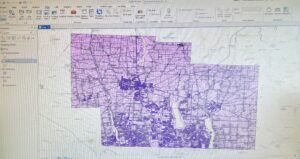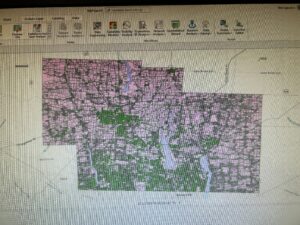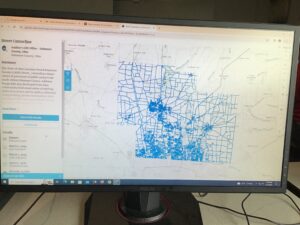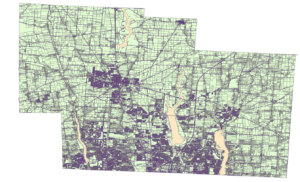
Month: March 2024
Huntington Week 6
9-1: Short tutorial on the use of buffer rings, useful for finding low-service areas.
9-2: A continuation of 9-1 that teaches you how to make multi-ring buffers.
9-3: Multiring buffers for calculating gravity models to do things like calculate travel times to service areas.
9-4: I’m really wishing I had finished this before I did my final oops. Network analyst tools are an excellent tool to determine and analyze service areas.
9-5: Not working.
10-1: Learned how to work with raster datasets, including extracting smaller datasets and making elevation maps.
10-2: Learning how to make heat maps using thresholds.
10-3: Making risk index models using geoprocessing
11-1: Cool 3d maps, learned how to move around the scene and change the basemap.
11-2: Learned how to create a local scene and make 3d vector data models called TIN surfaces.
11-3: Learned how to make 3d feature classes by Z-enabling them and edit 3d display settings.
11-4: Learned how to determine LOS and a whole bunch of distance data in 3d maps.
11-5: Learned how to edit various visual aspects of 3d models.
11-6: Learned about procedural methods for creating 3d models and using different texture styles.
11-7: Learning how to make an actual animation in GIS which is crazy. This is all stuff I know how to do from being an animation major and its very similar.
Roberts Week 7
- Address Point: A maintained and certified collection of addresses in Delaware county. Its primary listed uses deal with emergency response and reporting, especially when providing the information for 911 agencies.
- Annexation: Displays Delaware County boundaries from 1853 to the present. The data is up to date and is published monthly.
- Building Outline: Shows the outlines for all buildings in Delaware County. It says that it is updated as needed, with the most recent data being from 2021.
- Condo: Contains the polygons for all condominium buildings in Delaware County. In addition to the polygons it also contains information on the number of units and the recorded date of the condos, among other data.
- Dedicated ROW: Contains lines that represent all the ROWs (Right-of-Way) in Delaware County. The information is very up to date and well maintained, as it’s updated daily and published monthly.
- Delaware County Contours: Contains a two- foot elevation map (contour) of Delaware County. Can be downloaded in the form of a geodatabase.
- Delaware County E911 Data: Similar to Address Point, the E911 data contains information on the addresses in Delaware County with a more explicit purpose of emergency response usage.
- Farm Lot: Shows all of the farm lots in the US Military and the Virginia Military Survey Districts of Delaware County. It’s regularly updated and clearly shows the boundaries of the farm lots.
- GPS: Contains information on GPS monuments that were established between in the years 1991 and 1997. Information about the movements, such as their status (if they were destroyed or not) and their coordinates are included in the download.
- Hydrology: Shows LIDAR-enchanced data of all the major waterways present in Delaware County. This data set is also updated and published on a regular basis.
- Map Sheet: Shows all the map sheets covering Delaware County. Contains information such as the area and length of each map sheet.
- Original Township: Contains information on the boundaries of the 18 original townships in Delaware county. This information is more historic rather than up-to-date, as the shapes of the townships were changed with tax district adjustments.
- PLSS: Contains polygons that represent the PLSS- Public Land Survey System. It is updated and published regularly and helps easily identify the boundaries in multiple survey districts (including the US Military and the Virginia Military Survey Districts of Delaware County).
- Parcel: Includes the polygons of all parcels and their boundaries in Delaware County. The download contains information such as the address, owner, and class of each parcel. The data in the download is also updated daily and published regularly.
- Precinct: Shows the boundaries of the different voting precincts in Delaware County. The data is maintained with the assistance of the Delaware County Board of Elections and is updated frequently.
- Recorded Document: Contains points that represent documents that were recorded in Delaware county. These can include surveys, subdivisions, annexations, and more. There also appears to be links to PDFs of the official document.
- School District: Clearly illustrates the boundaries of each school district present within Delaware County. Includes information on the area and school name, among other data.
- Street Centerline: Shows a spatially accurate illustration of the center lines of all roads (public and private) in the county. It can be used in emergency response and disaster management while also containing information such as the speed limit and name of the street.
- Subdivision: Shows all subdivisions and condos in Delaware County. It is regularly updated and an effective visual illustration.
- Survey: Contains points that represent land surveys in Delaware County. Each point has multiple IDs that are observable upon clicking on the point. This dataset contains the newer surveys and is updated daily and published monthly.
- Tax District:Displays the boundaries of all the tax districts in Delaware County. There is information about the length and area of each district, which is all kept up to date.
- Township: Shows the shape, area, length, and name of the 19 townships of the county. It’s only updated as-needed, but is published monthly.
- Zip Code: Shows the boundaries of each of the zip codes present in Delaware county. You can find information about the actual zip code and name of area by selecting a polygon. The data is collected in collaboration with USPS and is updated monthly.

Miller Week 7
Delaware Data Inventory:
Address Point: Shows all the specific addresses for the county.
Annexation: Shows different parts or subdivisions of towns scattered throughout the county.
Building Outline: Shows the outline for all the structures present.
Condo: Shows all the different condo outlines.
Emergency 911 Data: Another way that shows address within the county, with a more spatially accurate data used for emergency response.
GPS: Shows all the GPS monuments made in the years 1991 and 1997.
Hydrology: Shows the county’s main water sources.
MSAG: Shows the political jurisdictions areas in the county,
Municipality: Shows the city limits of defined towns/cities in the county.
Paracel: Shows all the county’s specific zoning areas for each property.
Precinct: Shows the different voting areas within the county.
Recorded Document: Shows specific points where important data has been collected in the county.
School District: Shows all the school districts within the county.
Street Centerline: Gives accurate detail on all the roads present.
Subdivision: Shows all the subdivisions and condos as well in the county.
Tax District: Shows all the tax districts in the county.

week 7
Address Point-Data of all the registered building addresses in Delaware County. Specially accurate for reports.
Annexation-Displays all boundaries within Delaware County from 1853 onwards.
Building Outline-Represents the physical outlines of all buildings in the county.
Condo-Locations of all condominium complexes in the county.
Dedicated ROW-Indicates all right-of-way locations in Delaware County.
Delaware County Contours-Provides a 2-foot elevation map of the county.
Delaware County E911 data-Offers address points for emergency response purposes. Updated regularly.
Farm Lot-Shows all farm lots divided by US military and Virginia military survey distinctions.
GPS-Identifies all GPS monuments within the county.
Hydrology-Depicts major waterways flowing through Delaware County. Updated as needed.
MSAG-Lists all 28 townships within Delaware County.
Map Sheet-Displays all map sheets available for Delaware County.
Municipality-Highlights all political subdivisions within the county.
Original Township-Defines the original boundaries of the townships before tax district changes.
PLSS-Represents public land divisions within Delaware County.
Parcel-Shows cadastral parcel lines indicating real estate ownership and taxation.
Precinct-Indicates voting precincts, updated periodically.
Recorded Document-Identifies the location of various official documents recorded in the county.
School District-Displays the boundaries of school districts within Delaware County.
Street Centerline-Provides a roadmap of public and private roads within the county.
Subdivision-Represents both subdivisions and condominium complexes in the county.
Survey-Indicates various land surveys conducted within the county.
Tax District-Shows all divisions within tax districts, updated as needed.
Township-Depicts all townships within Delaware County.
Zip code data-Lists all zip codes within Delaware County, regularly updated.
Gassert, week 7
 Address point: Displays office addresses within Delaware County. Specially accurate with the intent of being able to be used for reports.
Address point: Displays office addresses within Delaware County. Specially accurate with the intent of being able to be used for reports.
Annexation: Shows all boundaries within Delaware County from 1853 to present.
Building outline 2021: Displays all building outlines in Delaware from 2021. I’d assume this needs updated.
Condo: Displays all condominium units/polygons recorded in the county.
Dedicated ROW: Shows all right of way lines in the county.
Delaware County contours: 2-foot contours from 2018. I would also assume this could be updated to be more recent.
Delaware County E911 data: Shows the address points from the previous “Address Points” layer. This gives 911 responders information to determine relative addresses to where a call comes from.
Farm lot: Shows all farm lots divided by US military and Virginia military survey distinctions in Delaware County.
GPS: Displays all GPS monuments identified in Delaware County between 1991 and 1997.
Hydrology: Shows every major waterway that runs through Delaware County. It was last updated in 2018 and is updated when needed.
MSAG: Acronym for “Master Street Address Guide”. It shows that there are 28 jurisdictions in Delaware County.
Map Sheet: Shows all map sheets in Delaware County.
Municipality: Shows all municipalities in Delaware County. (Political subdivisions)
Original township: Shows the original boundaries of Delaware County before tax district changes.
PLSS: Acronym for “Public Land Survey System”. It shows the PLSS polygons for the US military + Virginia military survey in Delaware County.
Parcel: Shows polygons that represent the cadastral parcel lines. Cadastral meaning real estate ownership and taxation.
Precinct: Shows various voting precincts. This gets updated when needed.
Recorded document: In place for miscellaneous documents like plat books, instrument records, and cabinet/slide data.
School district: Displays polygons that represent school districts within Delaware County.
Street centerline: Displays public + private roads in Delaware County.
Subdivision: Representative of all the subdivisions and condos in the county.
Survey: A shapefile that covers all the land surveys in the county.
Tax district: Shows all the divisions in tax districts in Delaware County. This is represented in polygons and is updated when needed.
Township: Shows all 19 townships that make up Delaware County.
Zipcode data: Consists of all the zipcodes listed in Delaware County. This gets updated regularly.
week 6
Chapter 9
9.1 – Explored the utilization of buffers for proximity analysis, involving operations such as running the pairwise buffer tool, selecting block centroids within buffers, and aggregating population data.
9.2 – Learned the intricacies of creating and implementing multiple-ring buffers and leveraging spatial overlay to obtain statistics based on buffer areas.
9.3 – Got into the creation of multiple-ring service areas essential for calibrating a gravity model. This involved generating service area polygons, spatially joining areas, pooling tags, calculating pool use statistics, creating scatterplots, and fitting curves to gravity model data points.
9.4 – Gained insights into utilizing network analyst to locate facilities and analyze optimal solutions within a given network.
9.5 – Explored data cluster analysis techniques and the interpretation of resulting clusters.
Chapter 10
10.1 – got into raster datasets, examining their properties, importing them into a file geodatabase, setting up the geoprocessing environment for raster analysis, and performing operations such as extracting land use and symbolizing raster datasets.
10.2 – Explored the creation of density heat maps, studying project locations, utilizing Kernel Density Smoothing (KDS), creating threshold contour layers, and estimating data rates from threshold areas.
10.3 – Engaged in building a risk index model, exploring project areas, standardizing input attributes, configuring geoprocessing environments, constructing models, setting up kernel density processes, and symbolizing resulting raster layers.
Chapter 11
11.1 – Explored global and local viewing models, navigating scenes, changing basemaps, applying visual enhancements, and understanding elevation surfaces.
11.2 – Learned to create local scenes, construct TIN surfaces, manipulate surfaces, and alter TIN symbology.
11.3 – Investigated the creation of z-enabled feature classes, digitizing data on surfaces, and displaying data realistically in 3D.
11.4 – Explored the creation of features and line-of-sight analysis using lidar data, generating DSM and DTM surfaces, creating nDSM raster surfaces, determining building heights, and conducting line-of-sight analysis.
11.5 – Delved into working with 3D features, extruding floors, visualizing building floors, and editing building heights dynamically.
11.6 – Explored procedural rules and multipatch models for creating 3D content, applying building rules, and viewing multipatch models.
11.7 – Learned to create animations, add keyframes, manage transitions, and export movies from animations.
week 5
4.1 – Explored various methods of importing and moving data within GIS Pro. Messed up setting up my connection folder but got it fixed with tutor, the remaining steps were comprehensible.
4.2 – Expanded knowledge on modifying attribute tables and utilizing the fields view. Although the steps were clear, encountering difficulty with displaying the population under 20 in expressions was notable.
4.3 – Dug deeper into attribute queries, effectively narrowing down specific data. It was particularly fascinating to isolate individual instances within the crime data.
4.4 – A quick and straightforward chapter, continuing to manipulate attribute tables and reutilize earlier steps from the book.
4.5 – Continued learning new features within the toolbox, including further exploration of the symbology tool.
4.6 – Another brief chapter focusing on attribute tables. Struggled with executing a one-to-many join section.
5.1 – Successfully adjusted the type of world map, finding the process relatively straightforward.
5.2 – Working with US maps followed comparable concepts.
5.3 – Incorporated new layers into specific coordinate systems and altered coordinate systems, presenting an intriguing process overall.
5.4 – Managed to comprehend the vector data donation section
5.5 – Encountered complexity within this section, struggling to locate/import the three consensus shape files, hindering progress for the remaining tasks.
6.1 – Successfully dissolved certain features to illustrate smaller neighborhoods, finding this section lucid and accessible.
6.3 – Effortlessly merged water features using the merge tool.
6.4 – Grappled with comprehending the purpose of the append tool. Nevertheless, executing the directions to attribute tables with specific data appeared straightforward.
6.5 – Intersected features to discern fire zones, finding the overall process .
6.6 – Summarized values within Brooklyn neighborhoods, grasping the utilization of the join tables tool.
6.7 – A section utilizing the tabulate intersection tool to compare disabled populations across different fire zones.
7.1 – editing polygons, altering shapes, and splitting them, finding the section both simple and engaging.
7.2 – The creation and deletion of polygons, finding the section equally straightforward.
7.3 – Used the smooth polygon tool, appreciating its ease of use and satisfying results.
7.4 – Focused on transforming polygons, requiring numerous steps but ultimately achieving the desired outcome.
8.1 – Commenced basic geocoding, primarily utilizing zip codes as data, finding the overall process relatively straightforward.
8.2 – Explored geocoding, this time with street addresses, encountering no significant hurdles in this straightforward section.
Week 4
Chapter 1
In this chapter, we explore the foundational elements of ArcGIS, covering basic navigation and the art of symbolizing and labeling maps in both 2D and 3D formats.
1.1 Understanding Feature Classes:
Feature classes serve as the backbone of map visualization, providing vector data with associated attributes. While raster datasets create imagery through pixels, feature classes offer rich spatial information. Stored in file geodatabases with basemaps, they enhance geographical context.
1.2 Navigating ArcGIS:
Efficient navigation involves using attribute values to search for features and employing tools like spatial bookmarks for quick access. Attribute manipulation allows for nuanced data analysis, including summary statistics computation.
1.3 Mastering Attribute Manipulation:
Attributes provide crucial contextual information for maps. ArcGIS enables users to manipulate attributes, reorder columns, and compute summary statistics with ease.
1.4 Enhancing Symbolization:
Symbolizing features involves altering colors, sizes, and shapes for effective communication. The use of 3D visualization is particularly impactful in urban contexts.
Chapter 2
This chapter explores advanced mapping techniques, including thematic maps, text management, symbolization techniques, and spatial analysis.
2.1 Exploring Thematic Maps:
Thematic maps highlight specific subjects within a spatial context, using lighter colors to reduce visual clutter.
2.2 Managing Textual Elements:
ArcGIS offers tools for managing labels and pop-ups, facilitating enriched map narratives. Definition queries enable targeted data exploration.
2.3 Perfecting Symbolization:
Symbolization choices enhance interpretability. Differentiation through shape variations ensures inclusivity, while classification methods like Natural Breaks and Quantiles enrich spatial analyses.
2.4 Precision Mapping:
Precision is essential in crafting visually compelling maps. ArcGIS offers tools for refining numeric attribute classes and utilizing advanced extrusion techniques for 3D mapping.
2.5 Innovating Mapping Techniques:
Dot density maps offer a versatile approach to visualizing data. Visibility ranges ensure seamless map interactions across zoom levels.
2.6 Leveraging Spatial Analysis:
Spatial analysis enables users to derive actionable insights from geospatial data. Normalizing population data facilitates comparative analyses.
2.7 Dynamic Mapping:
Advanced visualization techniques, including dynamic symbology and interactive elements, enhance user experiences. Augmented reality capabilities open new frontiers for spatial exploration.
2.8 Data Visualization:
Charts serve as powerful tools for elucidating complex patterns and trends. ArcGIS offers diverse charting options for crafting compelling narratives.
Chapter 3
This chapter focuses on crafting engaging map layouts, sharing maps online, and creating immersive narratives with ArcGIS Story Maps.
3.1 Designing Map Layouts:
Effective map composition is crucial for conveying information clearly. ArcGIS provides intuitive tools for creating visually compelling layouts.
3.2 Sharing Maps Online:
Sharing maps online facilitates collaboration and dissemination of information. ArcGIS simplifies the process of publishing maps online, fostering greater engagement.
3.3 Creating Immersive Narratives:
ArcGIS Story Maps enable users to weave interactive maps, text, images, and videos into captivating narratives. Users can create compelling stories that resonate with their audience.
Huntington Week 7
Address Point: Data of all the registered building addresses in Delaware county
Annexations: All annexations on Delaware county’s border from 1853 onwards
Building Outline: The physical outlines of all the buildings in the county
Condo: locations of all condo complexes in the county
Dedicated ROW: All Right-of-way locations in Delaware county
Delaware County Contours: 2 foot elevation map
Farm Lot: All the farm lots in the county
GPS: All the GPS monuments in the county
Hydrology: all the major waterways
MSAG: All 28 different townships in Delaware county
Map sheet: All the maps of the county
Municipality: All the municipalities
Original Township: the original boundaries of the towns
PLSS: Public land divisions in Delaware county
Parcel: All cadastral parcel lines
precinct: All voting precincts
Recorded document: The location of all official documents recorded in the county
School District: map of all the school districts
Street Centerline: Roadmap of Delaware county
subdivision: all the condos and divided housing
Survey: land survey
Tax district: tax districts
Township: More townships
Zipcode: All the zipcodes in the county
